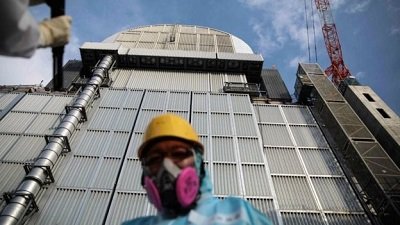
The operator of Japan’s Fukushima nuclear plant has begun removing nuclear fuel from a building housing one of the reactors that melted down after the 2011 earthquake and tsunami.
Remotely controlled equipment is lifting fuel rods from a storage pool near reactor number three.
The delicate work at the contaminated site is expected to take two years.
The next phase of the huge clean-up at reactor three will be to remove molten nuclear fuel that remains deep inside.
A spokeswoman for the Tokyo Electric Power Company (TEPCO) said the operation to remove the fuel had been delayed by earthquake debris inside the building as well as other technical issues.
Reactor buildings at the Fukushima Daiichi power plant were damaged by hydrogen explosions caused by the earthquake and tsunami. Three reactors melted down.
In the latest operation, more than 500 radioactive cylinders in the storage pool have to be placed in container casks which are then lifted from the compartment and transported by lorry to another pool of water for storage.
Radioactive gases could be released if the cylinders break or are exposed to air.
“We had to proceed carefully and we needed to take measures as dust would waft up and increase radiation readings,” spokeswoman Yuka Matsubara told AFP news agency.
The removal of molten nuclear fuel from inside the reactor number three building is not expected to begin until 2021 and is considered to be the most difficult part of the clean-up.
TEPCO says it plans to start removing fuel from the buildings housing reactors one and two, which also melted down, in 2023. In 2014, engineers removed fuel rods from near reactor four, which was offline at the time of the tsunami and, although damaged, did not suffer a meltdown.
The latest stage of the massive clean-up comes weeks after an evacuation order for one of two towns near the plant was lifted, allowing residents back for the first time since the disaster.
About 50 people were allowed to return to areas of Okuma, west of the Daiichi plant, after radiation levels were deemed safe.
However, correspondents say radiation remains a major concern for residents and the vast majority of the town’s original inhabitants are unlikely to go back.
The disaster at the nuclear power plant, about 62km (39 miles) south-east of the city of Fukushima, forced more than 470,000 people to be evacuated. –BBC





